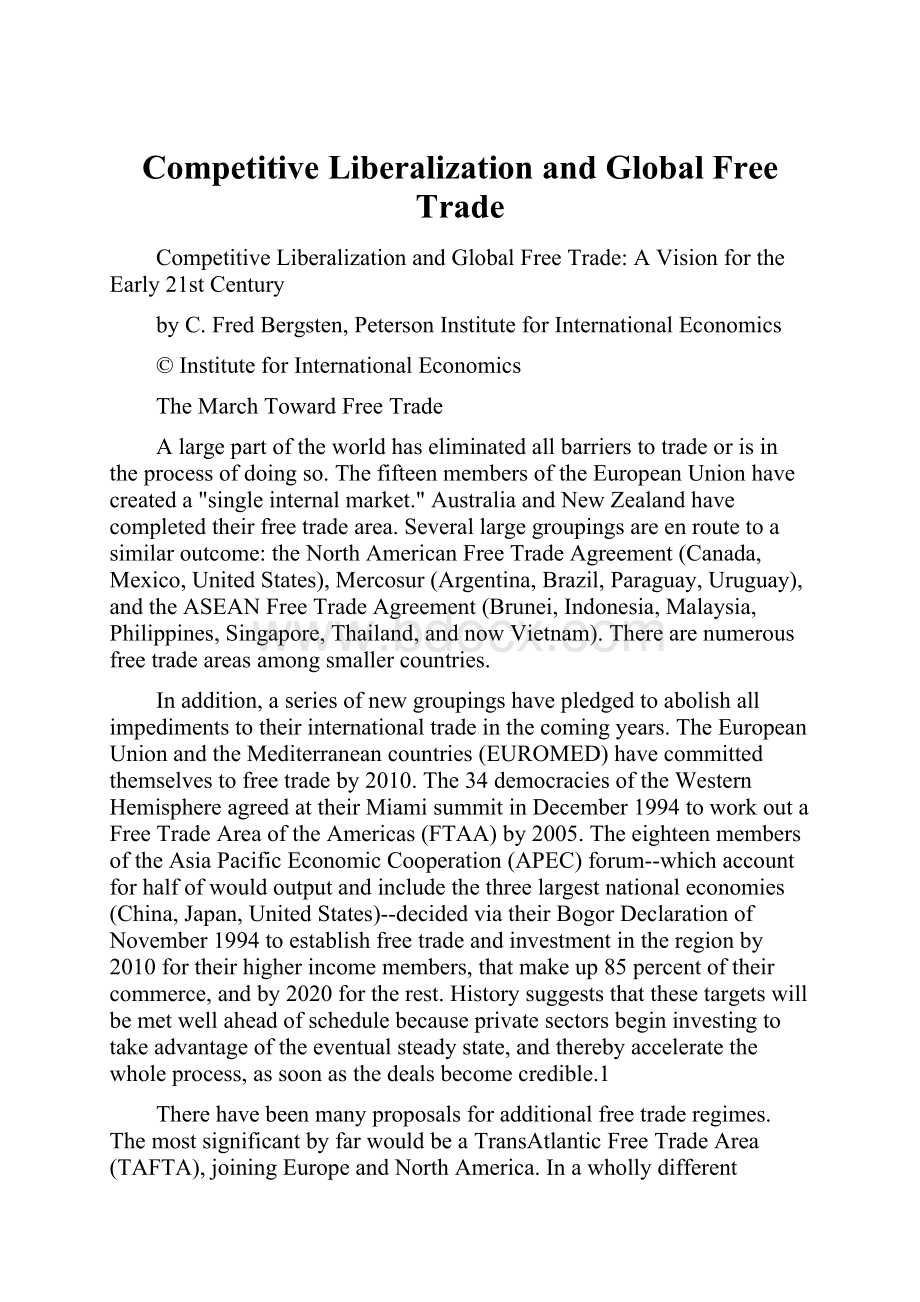 Competitive Liberalization and Global Free Trade.docx
Competitive Liberalization and Global Free Trade.docx
- 文档编号:9402145
- 上传时间:2023-02-04
- 格式:DOCX
- 页数:27
- 大小:36.86KB
Competitive Liberalization and Global Free Trade.docx
《Competitive Liberalization and Global Free Trade.docx》由会员分享,可在线阅读,更多相关《Competitive Liberalization and Global Free Trade.docx(27页珍藏版)》请在冰豆网上搜索。

CompetitiveLiberalizationandGlobalFreeTrade
CompetitiveLiberalizationandGlobalFreeTrade:
AVisionfortheEarly21stCentury
by C.FredBergsten,PetersonInstituteforInternationalEconomics
©InstituteforInternationalEconomics
TheMarchTowardFreeTrade
Alargepartoftheworldhaseliminatedallbarrierstotradeorisintheprocessofdoingso.ThefifteenmembersoftheEuropeanUnionhavecreateda"singleinternalmarket."AustraliaandNewZealandhavecompletedtheirfreetradearea.Severallargegroupingsareenroutetoasimilaroutcome:
theNorthAmericanFreeTradeAgreement(Canada,Mexico,UnitedStates),Mercosur(Argentina,Brazil,Paraguay,Uruguay),andtheASEANFreeTradeAgreement(Brunei,Indonesia,Malaysia,Philippines,Singapore,Thailand,andnowVietnam).Therearenumerousfreetradeareasamongsmallercountries.
Inaddition,aseriesofnewgroupingshavepledgedtoabolishallimpedimentstotheirinternationaltradeinthecomingyears.TheEuropeanUnionandtheMediterraneancountries(EUROMED)havecommittedthemselvestofreetradeby2010.The34democraciesoftheWesternHemisphereagreedattheirMiamisummitinDecember1994toworkoutaFreeTradeAreaoftheAmericas(FTAA)by2005.TheeighteenmembersoftheAsiaPacificEconomicCooperation(APEC)forum--whichaccountforhalfofwouldoutputandincludethethreelargestnationaleconomies(China,Japan,UnitedStates)--decidedviatheirBogorDeclarationofNovember1994toestablishfreetradeandinvestmentintheregionby2010fortheirhigherincomemembers,thatmakeup85percentoftheircommerce,andby2020fortherest.Historysuggeststhatthesetargetswillbemetwellaheadofschedulebecauseprivatesectorsbegininvestingtotakeadvantageoftheeventualsteadystate,andtherebyacceleratethewholeprocess,assoonasthedealsbecomecredible.1
Therehavebeenmanyproposalsforadditionalfreetraderegimes.ThemostsignificantbyfarwouldbeaTransAtlanticFreeTradeArea(TAFTA),joiningEuropeandNorthAmerica.Inawhollydifferentsetting,RussiahasproposedrevertingtofreetradeamongsomeoftherepublicsoftheformerSovietUnion.IndiaispromotinganassociationofcountriesthatrimtheIndianOcean.
Evenwithoutanyadditionalconfigurations,over60percentofinternationalcommercenowtakesplacewithinexistingorplannedfreetraderegimes(table1).Thisshareisrisingrapidly,bothbecauseoftheonsetofnewarrangementsandbecausetradeexpandsmorequicklyundersuchconditions.Thequestionthusarises:
whynoteliminatealltradebarriersthroughouttheworld?
WhynotlaunchamovementtowardglobalfreetradeattheWTOMinisterialConferenceinSingaporeinDecember1996?
Whyshouldn'tAPEC,havingagreedtoachievefreetradeinitsownregionbutnotwantingtocreateanewdiscriminatorybloc,proposethattheworldasawholeemulateitsapproach?
Table1:
RegionalFreeTradeArrangements(shareofworldtrade,1994)
EuropeanUnion
22.8
EUROMED
2.3
NAFTA
7.9
Mercosur
0.3
FreeTradeAreaoftheAmericas(inadditiontoitssubregionals)
2.6
AFTA
1.3
Australia-NewZealand
0.1
APEC(inadditiontoitssubregionals)
23.7
TOTAL
61.0
CompetitiveLiberalization
Inansweringthesequestions,itisfirstessentialtounderstandwhysomanycountries,insomanydifferentpartsoftheworld,withsuchdifferenteconomicsystems,atsuchdifferentstagesofdevelopment,haveallheadedinthesamedirection.Thereareofcoursedifferentnationalcircumstanceswhichexplainthedetailedstrategiesandtimingoftheindividualinitiatives.Theoverarchingforce,however,hasbeentheprocessofcompetitiveliberalization.
Therapidincreaseofglobalinterdependencehasforcedallcountries,whatevertheirpriorpoliciesorphilosophies,toliberalizetheirtrade(andusuallyinvestment)regimes.Economicsuccessintoday'sworldrequirescountriestocompeteaggressivelyforthefootlooseinternationalinvestmentthatgoesfartodeterminethedistributionofglobalproductionandthusjobs,profitsandtechnology.Mostcountriesofferdirectincentivestoforeigninvestorsbutanopentradeandinvestmentregimeisessentialforthispurpose.Mexicoovercameitshistoricaversionstotradeliberalizationandembracingitsnorthernneighbor,andproposedNAFTA,whenitbecameconvincedthatdoingsowasessentialtoavoidlosingoutintheglobalcompetitionforcapital.
Moreover,successintoday'sglobaleconomyrequirescountriestocompeteeffectivelyininternationalmarketsratherthansimplyathome.Thisistruenomatterhowlargethedomesticmarket:
theworld'smostself-containedeconomiesincludingBrazil,China,India,RussiaandperhapsmostnotablytheUnitedStates--whichmaintainedextensivequotesonautos,machinetools,steelandnumerousotherproductsonlyadecadeago--havealljoinedthecompetitiveliberalizationrace.
Competitiveliberalizationispursuedbycountriesthatuntilrecentlyhaddeeplyentrenchedprotectionisttraditions.Franceisadramaticcasesinpoint.SoisvirtuallyallofLatinAmerica,whichembracedimportantsubstitutiondoctrinesasrecentlyastwodecadesago.ThemoststunningreversalofallcomesfromtheformercommandeconomiesoftheCommunistworld,rangingfromChinathroughCentralEuropeandtheformerSovietUniontonowVietnam.
Anintellectualandideologicalsea-changeunderliesthishistoricdevelopment.Import-substitutionandevenautarkicmodelsofdevelopmentandnationaleconomicstrategywerereasonablyrespectableintothe1960sandeventhe1970s.Buttheirfollieswerethenexposed,includingbythethirdworlddebtcrisisofthe1980s,andreplacedbyanewconsensusof"outwardorientation."Thepoliticalonsetofconservativegovernmentsthroughouttheindustrializedworld,andinmanypartsofthedevelopingworldaswell,hastenedtheimplementationofthesereformmodels.
Thischangeinbasicthinkingdoesnot,however,explaintheonsetofregional(orotherinternational)tradearrangements.Whydidn'tthenewattitudesimplyproduceaspateofunilateraltradeliberalization,whichalltextbooksrecommendasthemostdirectroutetomaximizingtradebenefitsforanindividualcountry?
Theanswerliesinthepoliticsoftradereform.
ThePoliticalEconomyofTradeReform
Tobesure,agooddealofunilateralliberalizationhastakenplace.ThishasbeenespeciallytrueinEastAsia.IthasalsooccurredintheUnitedStates,mostofwhosequotaswereabolishedwithoutanyforeignquidproquo.Butdomesticpoliticaloppositionusuallyblockedcountriesfromsimplyabolishingtheirtraditionalbarriers.Entrenchedinterestsfoughthard,andfrequentlywithprolongedsuccess,tomaintaintheirprotectedpositions.Thepoliticsofeconomicreformweredifficultandcontentiousinvirtuallyeverycase.2
Thestandardstrategyforachievingtradereformwastomobilizeenoughpro-tradeintereststoovercomethosewhoresistedfurthermarketopening.Theseincludedbeneficiariesofimportssuchasconsumersandindustrialusersofimportedinputs.3 However,suchgroupsrarelyorganizedandtheirgainsfromliberalizationwerebothmodestandwidelydiffused.Hencetheyproducedlittlepoliticalcounterweightagainstthosewhowouldbeadverselyaffectedbyincreasedforeigncompetition.
Toovercomesuchopposition,itbecamenecessarytoappealtoexportersandotherswhogaindirectlyfromtheopeningofmarketsabroad.Thepoliticaleconomyoftradeliberalizationinindividualcountriesthusrestedheavilyonparallelliberalizationinpartnercountries.Themostassuredtechniqueforachievingsuchparallelactionwastoinsistonreciprocity,throughthenegotiationoftradeagreementswithenoughexistingorpotentialmarketstotiptheinternalbalanceinfavorofthedesiredliberalization.TheUnitedStatesfinallyagreedtogetridofitstextilequotasbynegotiatingforeignconcessionsfromtherestoftheworld,intheUruguayRoundattheGATT,onintellectualpropertyrightsandagriculturalbarriers.Throughthatsamenegotiation,JapanandKoreabegantoopentheirricemarketsbyappealingtotheexportinterestsoftheir(especiallyhigh-tech)manufacturers.
Negotiatedliberalizationthusturnedouttobefarmorefeasiblethanunilateralliberalization.Thekeybecameacountry'sabilitytopersuadeitsforeignpartnerstoproceedintandemwithit.Largetradingentities,suchastheUnitedStatesandtheEuropeanUnion,obviouslyhavethemostleverageinthiscontextbecauseoftheattractiontoothersoftheopeningoftheirmarkets.
Anotherkeyvariableisthestageofliberalizationatwhichacountryfindsitself.Initialreductionsofveryhightariffsarefrequentlyeasybecausetheyputfewdentsinthereallevelofprotectionandthuscanoftenbeimplementedunilaterally.Butmostcountrieshavefoundthattheymustapplythetraditionalpoliticaleconomyapproachtoengineerthelater(andmostbeneficial)phasesoftheprocess.
Chileisarecentcaseinpoint.Itspolicydesiretoachievetotallyfreetradeisclearbutitmustnowmobilizestrongsupportfromitsexporterstoovercomeresistancetoeliminatingitslast10percentorsoofprotection.Itsstrategyistotrytonegotiatereciprocaldealswhereveritcan--inMercosur,NAFTA,APEC,bilaterallyand/orgloballythroughthenewWorldTradeOrganization(WTO).
Regionalvs.GlobalLiberalization
Inseekingreciprocalliberalization,countriescouldturneithertotheirrespectivegeographicregionortotheglobaltradingsystemasawhole.Theglobalapproachisfundamentallysuperiorbecauseitmaximizesthenumberofforeignmarketsinvolvedandavoidstheeconomicdistortions(andpoliticalrisks)ofdiscrimination
- 配套讲稿:
如PPT文件的首页显示word图标,表示该PPT已包含配套word讲稿。双击word图标可打开word文档。
- 特殊限制:
部分文档作品中含有的国旗、国徽等图片,仅作为作品整体效果示例展示,禁止商用。设计者仅对作品中独创性部分享有著作权。
- 关 键 词:
- Competitive Liberalization and Global Free Trade
 冰豆网所有资源均是用户自行上传分享,仅供网友学习交流,未经上传用户书面授权,请勿作他用。
冰豆网所有资源均是用户自行上传分享,仅供网友学习交流,未经上传用户书面授权,请勿作他用。
链接地址:https://www.bdocx.com/doc/9402145.html


 1212中级汽车维修工考试试题三.docx
1212中级汽车维修工考试试题三.docx
